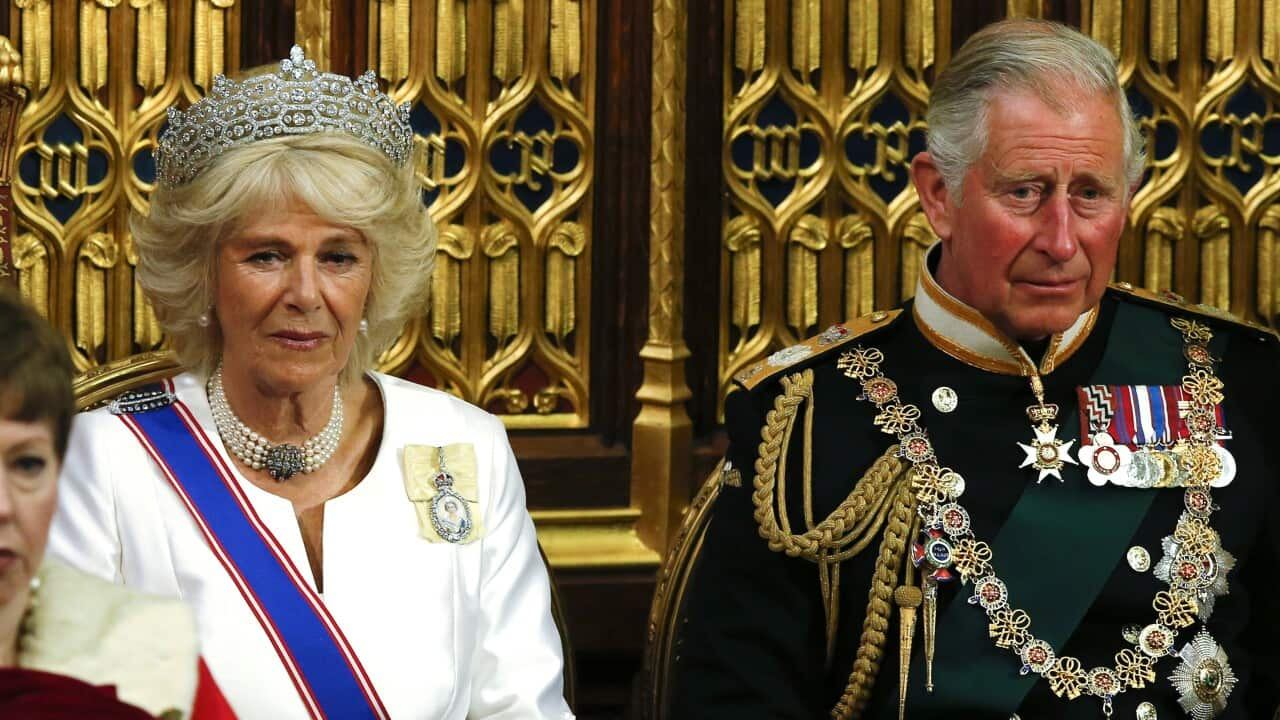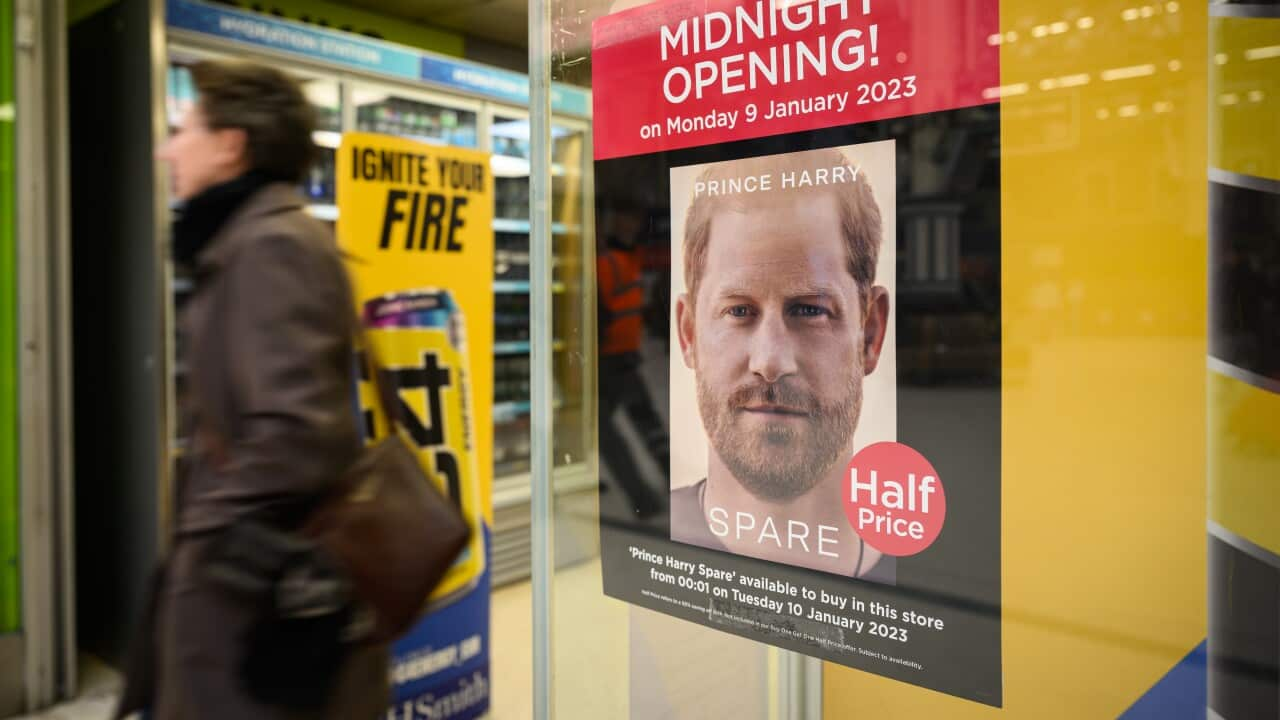Key Points
- Preparation for King Charles' coronation is in full swing.
- Buckingham Palace has said the event will "reflect the monarch's role today and look towards the future".
- Here's a look at some coronation traditions, and moments from ceremonies past.
The sacred oil has been sorted, new music commissioned, and the official emblem revealed.
Preparation for , is in full swing, with the pair to be crowned on 6 May.
It has been widely speculated the event will be scaled back compared to his mother 's 1953 coronation, and Buckingham Palace has said while it will be "rooted in long-standing traditions", it will also "reflect the monarch's role today and look towards the future".
Indeed, coronation emblem design gives a nod to the monarch's
The emblem features flora from the four nations that make up the United Kingdom - the rose of England, thistle of Scotland, daffodil of Wales, and shamrock of Northern Ireland, which was a tribute to the King's love of nature, according to Buckingham Palace.

King Charles' coronation emblem design gives a nod to the monarch's many years of environmental campaigning. Source: AAP / AP
And six orchestral commissions, five choral commissions, and one organ commission have been composed for the occasion, the palace has confirmed, including a new Coronation Anthem by musical theatre impresario Andrew Lloyd Webber.
"A range of musical styles and performers blend tradition, heritage and ceremony with new musical voices of today, reflecting The King's life-long love and support of music and the arts," the palace said in a February statement.
Here's a look at some coronation traditions, and moments from ceremonies past.
Coronation chicken
It's a British classic with royal beginnings.
was first served at the banquet for Queen Elizabeth's 1953 ceremony, where it appeared on the menu as Poulet Reine Elizabeth - or chicken Queen Elizabeth.
It was created by Her Majesty's florist, Constance Spry, and Rosemary Hume, who was the principal of London's Le Cordon Bleu cooking school at the time.
The dish consisted of cold chicken coated in a curry cream sauce served with a well-seasoned dressed salad of rice, green peas, and pimentos - a type of pepper.
But despite its origins, coronation chicken is not among the dishes Britons are being encouraged to serve on King Charles' coronation day.
The dishes include Ken Hom's Coronation Roast Rack of Lamb with Asian-style Marinade, Nadiya Hussain's Coronation Aubergine, and Adam Handling's Strawberry and Ginger Trifle.
Vegan-friendly holy oil
In the most sacred part of the coronation ceremony, the monarch is anointed with Chrism oil. Previous versions have been made with oil from the glands of a civet, and ambergris, which comes from the intestines of whales.
But not the version to be used on King Charles and Queen Consort Camilla. The newly consecrated oil has been made using olives harvested from two groves on the Mount of Olives in Jerusalem, at the Monastery of the Ascension and the Monastery of Mary Magdalene, the burial place of King Charles' grandmother Princess Alice of Greece.
The oil, perfumed with sesame, rose, jasmine, cinnamon, neroli, benzoin, and orange blossom, is based on that used for the coronation of the late Queen Elizabeth 70 years ago and a formula used for hundreds of years, Buckingham palace said on Friday.

The ampulla, used to contain the Chrism oil, and the coronation spoon used at the coronation of Britain's Queen Elizabeth in 1953. Source: AAP, Press Association / Matt Dunham/Alamy
Traditionally, the oil is poured from the ampulla (an elaborate gold container in the shape of an eagle) onto the Coronation Spoon and then the sovereign is anointed on their head, chest, and hands.
At the late Queen Elizabeth's coronation in 1953, television cameras cut away at this point as the moment was deemed too sacred to be broadcast.
Whether the anointing will be shown at King Charles' ceremony has not yet been revealed.
A 700-year-old chair
The historic coronation chair on which Henry VIII and other monarchs of England and later Britain have been crowned for some 700 years is getting a makeover ahead of this year's ceremony for King Charles.
The coronation chair was made on the orders of King Edward I to include the Stone of Scone, or Stone of Destiny, which had been used for the coronation of Scottish kings for centuries. Edward had brought down the Stone from Scotland in 1296.
It has featured in coronation ceremonies since 1308, and has been the chair used to crown monarchs since Henry IV in 1399, London's Westminster Abbey says.

Conservator Krista Blessley works on the restoration of the coronation chair, at Westminster Abbey in London, ahead of the upcoming coronation of King Charles III. Source: AAP, Press Association / Kirsty O'Connor/Alamy
A bomb attack in 1914, thought to have been organised by suffragettes (women campaigning for the right to vote), also knocked a small corner off it. Its base, which features a lion at each corner, was also replaced in the 18th century.
Meanwhile, Scottish Nationalists took the Stone of Scone on 25 December 1950, before it was recovered a few months later. The Stone was returned to Scotland in 1996 and is kept at Edinburgh Castle but will return to London for the coronation.
The latest conservation work will focus on cleaning the surface using sponges and cotton swabs to remove dirt, and stabilising surviving layers of gilding on the medieval chair and the base.
Coronation chaos
Many would think that coronations are meticulously planned events, but that has not, apparently, been the case on every occasion.
Queen Victoria's 1838 coronation was largely unrehearsed, and it showed.
The ceremony went on for five hours, and because of this, the monarch changed her outfit twice.
She recalled in her journal that the Archbishop of Canterbury placed her coronation ring on the wrong finger, which she later managed to remove but not without experiencing "great pain".
The monarch also recounted the moment Lord Rolle, a politician, fell as he went to pay homage to the Queen.
She wrote the "infirm" 87-year-old "in attempting to ascend the steps, fell and rolled quite down, but was not the least hurt".
"When he attempted to reascend them I got up and advanced to the end of the steps, in order to prevent another fall," she wrote.
It is also said a confused bishop , and she had to return to her seat to finish the service.
A bored-looking Charles
The now King Charles was four years old when he attended his mother Queen Elizabeth's coronation.
It was a historic moment for the then-Duke of Cornwall, who became the first child to witness his mother's coronation as a sovereign. His sister, Princess Anne, was too young to attend.
But the three-hour-long ceremony appeared to be all a bit much for the young royal, who was photographed resting his head on his propped-up hand while sporting a bored look on his face.

Prince Charles with his aunt, Princess Margaret (right) and his grandmother, Elizabeth the Queen Mother, at the 1953 Coronation of his mother, Queen Elizabeth II. Source: Getty / Hulton Deutsch/Corbis
He said was too short and his hair had been plastered to his head "with the most appalling gunge".
- With Reuters



